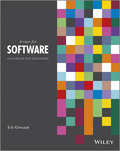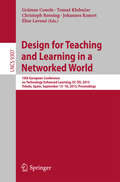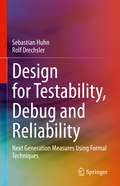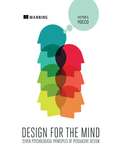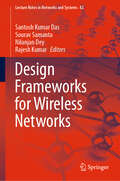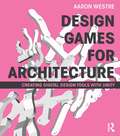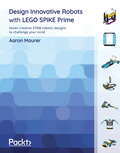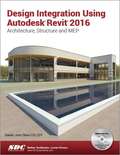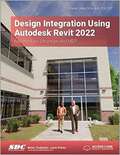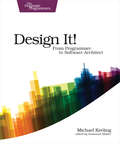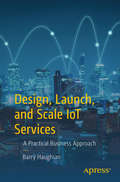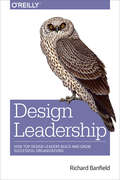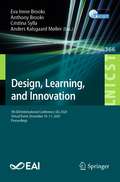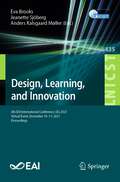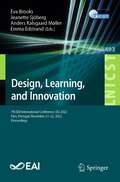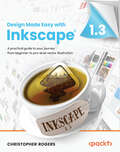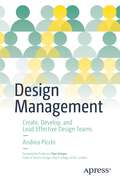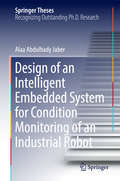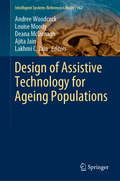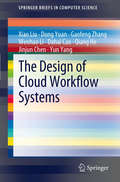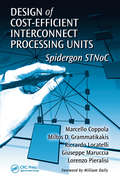- Table View
- List View
Design for Software
by Erik KlimczakA unique resource to help software developers create a desirable user experience Today, top-flight software must feature a desirable user experience. This one-of-a-kind book creates a design process specifically for software, making it easy for developers who lack design background to create that compelling user experience. Appealing to both tech-savvy designers and creative-minded technologists, it establishes a hybrid discipline that will produce first-rate software. Illustrated in full color, it shows how to plan and visualize the design to create software that works on every level. Today's software demands attention to the quality of the user experience; this book guides you through a practical design process to achieve that goal Approaches the mechanics of design with a process inspired by art and science Avoids the abstract and moves step by step through techniques you can put to use immediately Covers planning your design, tested methods, how to visualize like a designer, psychology of design, and how to create software that developers will appreciate Explores such elements as choosing the right typeface and managing interactivity Design for Software: A Playbook for Developers brings the art of good design together with the science of software development to create programs with pizazz.
Design for Teaching and Learning in a Networked World: 10th European Conference on Technology Enhanced Learning, EC-TEL 2015, Toledo, Spain, September 15-18, 2015, Proceedings (Lecture Notes in Computer Science #9307)
by Gráinne Conole Tomaž Klobučar Christoph Rensing Johannes Konert Élise LavouéThis book constitutes the refereed proceedings of the 10th European Conference on Technology Enhanced Learning, EC-TEL 2015, held in Toledo, Spain, in September 2015. The 27 full papers, 19 short papers, 9 demo papers and 23 posters were carefully reviewed and selected from 176 submissions. They address topics such as blended learning; self-regulated and self directed learning; reflective learning; intelligent learning systems; learning communities; learning design; learning analytics; learning assessment; personalization and adaptation; serious games; social media; massive open online courses (MOOCs); schools of the future.
Design for Testability, Debug and Reliability: Next Generation Measures Using Formal Techniques
by Sebastian Huhn Rolf DrechslerThis book introduces several novel approaches to pave the way for the next generation of integrated circuits, which can be successfully and reliably integrated, even in safety-critical applications. The authors describe new measures to address the rising challenges in the field of design for testability, debug, and reliability, as strictly required for state-of-the-art circuit designs. In particular, this book combines formal techniques, such as the Satisfiability (SAT) problem and the Bounded Model Checking (BMC), to address the arising challenges concerning the increase in test data volume, as well as test application time and the required reliability. All methods are discussed in detail and evaluated extensively, while considering industry-relevant benchmark candidates. All measures have been integrated into a common framework, which implements standardized software/hardware interfaces.
Design for the Mind: Seven Psychological Principles of Persuasive Design
by Victor YoccoSummaryDesign for the Mind: Seven Psychological Principles of Persuasive Design teaches web designers and developers how to create sites and applications that appeal to our innate natural responses as humans. Author Victor Yocco, a researcher on psychology and communication, introduces the most immediately relevant and applicable psychological concepts, breaks down each theory into easily-digested principles, then shows how they can be used to inform better design.Purchase of the print book includes a free eBook in PDF, Kindle, and ePub formats from Manning Publications.About the TechnologyDesigners and design team members need to think about more than just aesthetics. How do you handle short attention spans. How does your design encourage users to engage, browse, or buy? Fortunately, there are psychological principles that you can use in your design to anticipate and benefit from how humans think, behave, and react.About the BookDesign for the Mind: Seven Psychological Principles of Persuasive Design teaches you to recognize how websites and applications can benefit from an awareness of our innate, natural responses as humans, and to apply the same principles to your own designs. This approachable book introduces the psychological principles, deconstructs each into easily digestible concepts, and then shows how you can apply them. The idea is to deepen your understanding of why people react in the ways they do. After reading the book, you'll be ready to make your work more psychologically friendly, engaging, and persuasive.What's InsideMaking design persuasiveEncouraging visitors to take actionCreating enduring messagesMeeting the needs of both engaged and disengaged visitorsBecoming a strategic influencerApplying theory, with case studies and real-world examplesAbout the ReaderThis book is for web and UX designers and developers as well as anyone involved in customer-facing digital products.About the AuthorVictor Yocco, PhD, is a research director at a Philadelphia-based digital design firm. He received his PhD from The Ohio State University, where his research focused on psychology and communication in informal learning settings. Victor regularly writes and speaks on topics related to the application of psychology to design and addressing the culture of alcohol use in design and technology. He can be found at www.victoryocco.com or @victoryocco on Twitter.Table of ContentsPART 1 INTRODUCING THE APPLICATION OF PSYCHOLOGY TO DESIGNMeeting users' needs: including psychology in designPART 2 WHY DO FOLKS ACT LIKE THAT? PRINCIPLES OF BEHAVIORDesigning for regular use: addressing planned behaviorRisky decisions and mental shortcutsMotivation, ability, and trigger-boom!PART 3 PRINCIPLES OF INFLUENCE AND PERSUASION: NOT AS EVIL AS YOU'D THINKInfluence: getting people to like and use your designUsing family, friends, and social networks to influence usersIt's not what you say; it's how you say it!Persuasion: the deadliest artPART 4 USER EXPERIENCE DESIGN: PUTTING IT ALL TOGETHERCase study: KidTech Design Co.'s Good Choice appThe next step: getting up and running
Design Frameworks for Wireless Networks (Lecture Notes in Networks and Systems #82)
by Santosh Kumar Das Sourav Samanta Nilanjan Dey Rajesh KumarThis book provides an overview of the current state of the art in wireless networks around the globe, focusing on utilizing the latest artificial intelligence and soft computing techniques to provide design frameworks for wireless networks. These techniques play a vital role in developing a more robust algorithm suitable for the dynamic and heterogeneous environment, making the network self-managed, self-operational, and self-configurational, and efficiently reducing uncertainties and imprecise information.
Design für Testbarkeit, Fehlersuche und Zuverlässigkeit: Maßnahmen der nächsten Generation unter Verwendung formaler Techniken
by Sebastian Huhn Rolf DrechslerIn diesem Buch werden mehrere neue Ansätze vorgestellt, die den Weg für die nächste Generation integrierter Schaltungen ebnen, die auch in sicherheitskritischen Anwendungen erfolgreich und zuverlässig integriert werden können. Die Autoren beschreiben neue Maßnahmen zur Bewältigung der steigenden Herausforderungen im Bereich des Designs für Testbarkeit, Fehlersuche und Zuverlässigkeit, die für moderne Schaltungsentwürfe unbedingt erforderlich sind. Insbesondere werden in diesem Buch formale Techniken wie das Satisfiability (SAT)-Problem und das Bounded Model Checking (BMC) kombiniert, um die entstehenden Herausforderungen in Bezug auf die Zunahme des Testdatenvolumens, die Testanwendungszeit und die erforderliche Zuverlässigkeit zu bewältigen. Alle Methoden werden detailliert diskutiert und unter Berücksichtigung von industrie-relevanten Benchmark-Kandidaten ausführlich evaluiert. Alle Maßnahmen wurden in ein gemeinsames Framework integriert, das standardisierte Software/Hardware-Schnittstellen implementiert.
Design Games for Architecture: Creating Digital Design Tools with Unity
by Aaron WestreDesign Games for Architecture teaches you how to create playful software tools based on your architectural design processes, whether or not you are familiar with game design technology. The book combines the fun and engaging aspects of video games to ease the sometimes complex process of learning software development. By working through exercises illustrated with screen shots and code, you acquire knowledge about each step required to build useful tools you can use to accomplish design tasks. Steps include analysing design processes to identify their logic, translating that logic into a collection of objects and functions, then encoding the design procedure into a working software tool. Examples presented in the book are design games---tools that a designer “plays” like video games---that span a wide range of design activities. These software tools are built using Unity, free, innovative, and industry-leading software for video game development. Unity speeds up the process of software creation, offers an interface that will be familiar to you, and includes very advanced tools for creating forms, effects, and interactivity. If you are looking to add cutting-edge skills to your repertoire, then Design Games will help you sharpen your design thinking and allow you to specialize in this new territory while you learn more about your own design processes.
Design in Educational Technology: Design Thinking, Design Process, and the Design Studio
by Brad Hokanson Andrew GibbonsThis book is the result of a research symposium sponsored by the Association for Educational Communications and Technology [AECT]. The fifteen chapters were developed by leaders in the field and represent the most updated and cutting edge methodology in the areas of instructional design and instructional technology. The broad concepts of design, design thinking, the design process, and the design studio, are identified and they form the framework of the book. This book advocates the conscious adoption of a mindset of design thinking, such as that evident in a range of divergent professions including business, government, and medicine. At its core is a focus on "planning, inventing, making, and doing." (Cross, 1982), all of which are of value to the field of educational technology. Additionally, the book endeavors to develop a deep understanding of the design process in the reader. It is a critical skill, often drawing from other traditional design fields. An examination of the design process as practiced, of new models for design, and of ways to connect theory to the development of educational products are all fully explored with the goal of providing guidance for emerging instructional designers and deepening the practice of more advanced practitioners. Finally, as a large number of leading schools of instructional design have adopted the studio form of education for their professional programs, we include this emerging topic in the book as a practical and focused guide for readers at all levels.
Design Innovative Robots with LEGO SPIKE Prime: Seven creative STEM robotic designs to challenge your mind
by Aaron MaurerDiscover how to use the LEGO SPIKE Prime kit and boost your confidence in robotics, coding, and engineeringKey FeaturesGet up and running with new parts not seen in previous LEGO kitsGain deeper insights into non-compatible sensors and components that work with all prior LEGO components and third-party elementsExplore new features and experiment with new robot builds with LEGO's new coding platformBook DescriptionThe new LEGO SPIKE Prime is one of the latest additions to the LEGO robotics line of products. This book will help you to enjoy building robots and understand how exciting robotics can be in terms of design, coding, and the expression of ideas. The book begins by taking you through a new realm of playful learning experiences designed for inventors and creators of any age. In each chapter, you'll find out how to build a creative robot, learn to bring the robot to life through code, and finally work with exercises to test what you've learned and remix the robot to suit your own unique style. Throughout the chapters, you'll build exciting new smart robots such as a handheld game, a robotic arm with a joystick, a guitar, a flying bird, a sumobot, a dragster, and a Simon Says game. By the end of this LEGO book, you'll have gained the knowledge and skills you need to build any robot that you can imagine.What you will learnDiscover how the LEGO SPIKE Prime kit works, and explore its parts and the elements inside themBuild and design robots that go beyond basic robotic designsCreate interactive robots with the help of sensorsExplore real-world robots and learn how to build them by yourselfFind out challenging ways to remix build ideas with your own imagination and skillsDevelop coding skills using the Scratch programming interfaceWho this book is forThis book is for robot enthusiasts, LEGO lovers, hobbyists, educators, students, and anyone looking to learn about the new LEGO SPIKE Prime kit. The book is designed to go beyond the basic builds to intermediate and advanced builds, while also helping you to learn how to add your own personal touch to the builds and code. To make the most of this book, you'll need a basic understanding of build techniques, coding in block-based software environments, and weaving them together to create unique robot builds.
Design Integration Using Autodesk Revit 2016
by Daniel John StineDesign Integration Using Autodesk Revit 2016
Design Integration Using Autodesk Revit 2022
by Daniel John StineDesign Integration Using Autodesk Revit 2022 is designed to provide you with a well-rounded knowledge of Autodesk Revit tools and techniques. <p><p>All three disciplines of the Revit platform are introduced in this textbook. This approach gives you a broad overview of the Building Information Modeling (BIM) process. The topics cover the design integration of most of the building disciplines: Architectural, Interior Design, Structural, Mechanical, Plumbing and Electrical. Civil is not covered, but adding topography to your model is. Each book also includes access to nearly 100 video tutorials designed to further help you master Autodesk Revit. <p><p> Throughout the book you develop a two story law office. The drawings start with the floor plans and develop all the way to photo-realistic renderings similar to the one on the cover of this book. Along the way the building’s structure, ductwork, plumbing and electrical (power and lighting) are modeled. By the end, you will have a thorough knowledge of many of the Revit basics needed to be productive in a classroom or office environment. Even if you will only be working with one component of Revit in your chosen profession, this book will give you important knowledge on how the other disciplines will be doing their work and valuable insight into the overall process. <p><p> The first four chapters cover many of the Revit basics needed to successfully and efficiently work with the software. Once the fundamentals are covered, the remaining chapters walk you through a building project which is started from scratch so nothing is taken for granted by you or the author.
Design Is The Problem
by Nathan ShedroffDesign makes a tremendous impact on the produced world in terms of usability, resources, understanding, and priorities. What we produce, how we serve customers and other stakeholders, and even how we understand how the world works is all affected by the design of models and solutions. Designers have an unprecedented opportunity to use their skills to make meaningful, sustainable change in the world--if they know how to focus their skills, time, and agendas. In Design is the Problem: The Future of Design Must be Sustainable, Nathan Shedroff examines how the endemic culture of design often creates unsustainable solutions, and shows how designers can bake sustainability into their design processes in order to produce more sustainable solutions.
Design It!: From Programmer to Software Architect
by Michael KeelingDon't engineer by coincidence-design it like you mean it! Filled with practical techniques, Design It! is the perfect introduction to software architecture for programmers who are ready to grow their design skills. Lead your team as a software architect, ask the right stakeholders the right questions, explore design options, and help your team implement a system that promotes the right -ilities. Share your design decisions, facilitate collaborative design workshops that are fast, effective, and fun-and develop more awesome software!With dozens of design methods, examples, and practical know-how, Design It! shows you how to become a software architect. Walk through the core concepts every architect must know, discover how to apply them, and learn a variety of skills that will make you a better programmer, leader, and designer. Uncover the big ideas behind software architecture and gain confidence working on projects big and small. Plan, design, implement, and evaluate software architectures and collaborate with your team, stakeholders, and other architects. Identify the right stakeholders and understand their needs, dig for architecturally significant requirements, write amazing quality attribute scenarios, and make confident decisions. Choose technologies based on their architectural impact, facilitate architecture-centric design workshops, and evaluate architectures using lightweight, effective methods. Write lean architecture descriptions people love to read. Run an architecture design studio, implement the architecture you've designed, and grow your team's architectural knowledge. Good design requires good communication. Talk about your software architecture with stakeholders using whiteboards, documents, and code, and apply architecture-focused design methods in your day-to-day practice. Hands-on exercises, real-world scenarios, and practical team-based decision-making tools will get everyone on board and give you the experience you need to become a confident software architect.
Design, Launch, and Scale IoT Services: A Practical Business Approach
by Barry HaughianThe Internet of Things is causing major industry disruption, so companies need to plan and manage their “IoT journey” to maximize all business opportunities. In this book companies can learn how to successfully create, launch and manage Internet of Things services. It takes the reader through the process of specifying, implementing, and deploying IoT services; detailing how to scale and manage an IoT business. It introduces the fundamentals of IoT services, explaining IoT service building blocks and the key factors to be considered in the design of IoT services. Moving into the IoT field requires speed. This book provides a fast track approach to IoT; summarizing the global experiences of the author, detailing the discussions, mistakes, successes, learnings and conclusions. Building an Internet of Things Service enables readers to accelerate their own on-boarding in their IoT journey.What You'll LearnCreate new IoT ServicesReview the basic IoT concepts and business implications you need to know as you embark on your IoT journeySolve the major challenges presented by the IoT disruption.Accelerate your own on-boarding in their IoT journey.Who This Book Is ForThe primary audience is made up of business executives and IoT startups. The secondary audience is students studying IoT in universities and those interested in understanding the fundamentals of an IoT business. No technical background is required.
Design Leadership
by Richard BanfieldWhat does it take to be the leader of a design firm or group? We often assume they have all the answers, but in this rapidly evolving industry they're forced to find their way like the rest of us. So how do good design leaders manage? If you lead a design group, or want to understand the people who do, this insightful book explores behind-the-scenes strategies and tactics from leaders of top design companies throughout North America.Based on scores of interviews he conducted over a two-year period--from small companies to massive corporations like ESPN--author Richard Banfield covers a wide range of topics, including:How design leaders create a healthy company cultureInnovative ways for attracting and nurturing talentCreating productive workspaces, and handling remote employeesStaying on top of demands while making time for themselvesConsistent patterns among vastly different leadership stylesTechniques and approaches for keeping the work pipeline fullMaking strategic and tactical plans for the futureMistakes that design leaders made--and how they bounced back
Design, Learning, and Innovation: 5th EAI International Conference, DLI 2020, Virtual Event, December 10-11, 2020, Proceedings (Lecture Notes of the Institute for Computer Sciences, Social Informatics and Telecommunications Engineering #366)
by Eva Irene Brooks Anthony Brooks Cristina Sylla Anders Kalsgaard MøllerThis book constitutes the refereed post-conference proceedings the 5th EAI International Conference on DLI 2020, Design, Leaning and Innovation, which took place in December 2020. Due to COVID-19 pandemic the conference was held virtually. The 14 revised full papers presented were carefully selected from 40 submissions and are organized in four thematic sessions on: digital technologies and learning; designing for innovation; digital games, gamification and robots; designs for innovative learning.
Design, Learning, and Innovation: 6th EAI International Conference, DLI 2021, Virtual Event, December 10-11, 2021, Proceedings (Lecture Notes of the Institute for Computer Sciences, Social Informatics and Telecommunications Engineering #435)
by Eva Brooks Jeanette Sjöberg Anders Kalsgaard MøllerThis book constitutes the refereed post-conference proceedings the 6th EAI International Conference on Design, Leaning and Innovation, DLI 2021, which took place in December 2021. Due to COVID-19 pandemic the conference was held virtually. The theme for DLI 2021 was “Shifting boundaries to discover novel ways and emerging technologies to realise human needs, ideas, and desires” targeting a conceptualisation of the effects and impact of digital technologies for, in an inclusive and playful way, fostering human beings to realising their needs, ideas and desires. The 17 revised full papers presented were carefully selected from 36 submissions and are organized in four thematic sessions on: digital technologies, design and learning; tools and models; artificial intelligence, virtual reality and augmented reality in learning; innovative designs and learning.
Design, Learning, and Innovation: 7th EAI International Conference, DLI 2022, Faro, Portugal, November 21-22, 2022, Proceedings (Lecture Notes of the Institute for Computer Sciences, Social Informatics and Telecommunications Engineering #493)
by Eva Brooks Jeanette Sjöberg Anders Kalsgaard Møller Emma EdstrandThis book constitutes the refereed post-conference proceedings the 7th International Conference on Design, Leaning and Innovation, DLI 2022, which took place in Faro, Portugal, in November 21-22, 2022. The 4 revised full papers and 2 short papers presented were carefully selected from 32 submissions on. They were organized in topical sections as follows: Digital Environments and Design Processes Fostering Learning and Interaction, Designs for Innovative Learning with Digital Technology, Digital Approaches Shaping Educational Practices.
Design Made Easy with Inkscape: A practical guide to your journey from beginner to pro-level vector illustration
by Christopher RogersDiscover quick and easy ways to make charts, diagrams, illustrations, and UX/UI mockups with end-to-end guidance using hands-on tutorials, tips, and tricksKey FeaturesGet up to speed with vector illustration in no timeExplore hotkey charts and tips, with best practices developed over ten years of using InkscapeLearn the fundamentals of vector illustration and efficiently leverage Inkscape's powerful toolsetBook DescriptionWith the power and versatility of the Inkscape software, making charts, diagrams, illustrations, and UI mockups with infinite resolution becomes enjoyable. If you're looking to get up to speed with vector illustration in no time, this comprehensive guide has got your back! Design Made Easy with Inkscape is easy to follow and teaches you everything you need to know to create graphics that you can use and reuse forever, for free! You'll benefit from the author's industry experience as you go over the basics of vector illustration, discovering tips and tricks for getting professional graphics done fast by leveraging Inkscape's powerful toolset. This book teaches by example, using a great variety of use cases from icons and logos to illustration, web design, and product design. You'll learn about hotkeys and take a best-practices approach developed over ten years of using Inkscape as a design tool in production. What's more, this book also includes links to free graphics resources that you can use in all your projects. Whether you're a new user or a professional, by the end of this book, you'll have full understanding of how to use Inkscape and its myriad of excellent features to make stunning graphics for your projects.What you will learnUnderstand the benefits of vector illustration and the reasons behind choosing Inkscape over other non-free alternativesNavigate the Inkscape setup and workspace to make effective use of the softwareExplore the wide range of tools from Inkscape to create amazing and infinitely scalable graphics quicklyUse real-world scenarios and practice lessons to learn how to create by exampleDiscover tips and tricks to make Inkscape an extension of your creativityConvert photos to vector art and practice with professional design examples as you work with layers, shading, coloring and much moreWho this book is forThis book is for aspiring designers, developers, and anyone who wants to leverage the power of Inkscape for vector illustration. No prior knowledge of graphics applications or vector and raster graphics is required. This book simplifies Inkscape for dummies; all you need to know is how to use a mouse and keyboard.
Design Management: Create, Develop, and Lead Effective Design Teams
by Andrea PicchiDesigners are more in-demand than ever, and companies all over the world are creating new leadership roles to manage them. With only a few select institutions teaching effective design management skills, self-taught design managers are on the rise and resources are needed to guide them. This book will help you hone your leadership skills and magnify your team’s potential. Eager designers will learn the behavioral abilities required to lead and manage impactful and efficient teams using a systemic, context-agnostic, and therefore repeatable approach. While effective design management is vital in these times of complexity and fast change in organizations, the available literature on design management is insufficient, predominately informative, and unfortunately, not actionable. This book fills that gap by illuminating the soft skills you need to lead your team to success. You'll gain confidence about how to optimize meetings, run successful kickoffs, manage yourself, and how to best approach and frame your working environment. Whether you are a designer looking to lead, or a member of an organization looking for guidance on how to better incorporate design, this book belongs on your shelf. Design Management is here to assist you in the long haul.What You'll LearnComprehend the underlying social and psychological dynamics of leadership and managementCultivate the behavioral elements of a design managerUnderstand the building blocks of a design leaderEstablish your core practices and create a self-development programDevelop and project healthy and sustainable influenceBuild trust, create psychological safety, and fulfill the social needs of high-performing teamsCoach individuals and groups to unlock creativity and nurture creative collaborationOptimize in-person and remote design operations Who This Book Is ForEveryone who desires to expand and deepen their knowledge of design leadership and management, comprehending the social and psychological underpinning elements of this discipline. Aspiring or recently appointed design leaders and managers who necessitate a practical education in this field and individuals already in charge of a group who aspire to evolve their understanding to advance their career toward a Head of Design or Chief Design Officer role.
Design of an Intelligent Embedded System for Condition Monitoring of an Industrial Robot
by Alaa Abdulhady JaberThis thesis introduces a successfully designed and commissioned intelligent health monitoring system, specifically for use on any industrial robot, which is able to predict the onset of faults in the joints of the geared transmissions. However the developed embedded wireless condition monitoring system leads itself very well for applications on any power transmission equipment in which the loads and speeds are not constant, and access is restricted. As such this provides significant scope for future development. Three significant achievements are presented in this thesis. First, the development of a condition monitoring algorithm based on vibration analysis of an industrial robot for fault detection and diagnosis. The combined use of a statistical control chart with time-domain signal analysis for detecting a fault via an arm-mounted wireless processor system represents the first stage of fault detection. Second, the design and development of a sophisticated embedded microprocessor base station for online implementation of the intelligent condition monitoring algorithm, and third, the implementation of a discrete wavelet transform, using an artificial neural network, with statistical feature extraction for robot fault diagnosis in which the vibration signals are first decomposed into eight levels of wavelet coefficients.
Design of Arithmetic Circuits in Quantum Dot Cellular Automata Nanotechnology
by K. Sridharan Vikramkumar PudiThis research monograph focuses on the design of arithmetic circuits in Quantum Dot Cellular Automata (QCA). Using the fact that the 3-input majority gate is a primitive in QCA, the book sets out to discover hitherto unknown properties of majority logic in the context of arithmetic circuit designs. The pursuit for efficient adders in QCA takes two forms. One involves application of the new results in majority logic to existing adders. The second involves development of a custom adder for QCA technology. A QCA adder named as hybrid adder is proposed and it is shown that it outperforms existing multi-bit adders with respect to area and delay. The work is extended to the design of a low-complexity multiplier for signed numbers in QCA. Furthermore the book explores two aspects unique to QCA technology, namely thermal robustness and the role of interconnects. In addition, the book introduces the reader to QCA layout design and simulation using QCADesigner. Features & Benefits: This research-based book: ·Introduces the reader to Quantum Dot Cellular Automata, an emerging nanotechnology. ·Explores properties of majority logic. ·Demonstrates application of the properties to design efficient arithmetic circuits. ·Guides the reader towards layout design and simulation in QCADesigner.
Design of Assistive Technology for Ageing Populations (Intelligent Systems Reference Library #167)
by Andree Woodcock Louise Moody Deana McDonagh Ajita Jain Lakhmi C. JainThis book focuses on various aspects of research on aging, including in relation to assistive technology; dignity of aging; how technology can support a greater understanding of the experience of physically aging and cognitive changes; mobility issues associated with the elderly; and emerging technologies. The 80+ age group represents an expanding market, with an estimated worth of £21.4 billion a year. Everyone is affected by this shift in demographics – we are getting older and may become carers – and we need to prepare ourselves and adjust our surroundings for longer life. Products, services and environments have been changing in response to the changing population. Presenting international design research to demonstrate the thinking and ideas shaping design, this book is a valuable resource for designers; product developers; employers; gerontologists; and medical, health and service providers; as well as everyone interested in aging.
The Design of Cloud Workflow Systems
by Qiang He Dahai Cao Dong Yuan Wenhao Li Xiao Liu Yun Yang Gaofeng Zhang Jinjun ChenCloud computing is the latest market-oriented computing paradigm which brings software design and development into a new era characterized by "XaaS", i.e. everything as a service. Cloud workflows, as typical software applications in the cloud, are composed of a set of partially ordered cloud software services to achieve specific goals. However, due to the low QoS (quality of service) nature of the cloud environment, the design of workflow systems in the cloud becomes a challenging issue for the delivery of high quality cloud workflow applications. To address such an issue, this book presents a systematic investigation to the three critical aspects for the design of a cloud workflow system, viz. system architecture, system functionality and quality of service. Specifically, the system architecture for a cloud workflow system is designed based on the general four-layer cloud architecture, viz. application layer, platform layer, unified resources layer and fabric layer. The system functionality for a cloud workflow system is designed based on the general workflow reference model but with significant extensions to accommodate software services in the cloud. The support of QoS is critical for the quality of cloud workflow applications. This book presents a generic framework to facilitate a unified design and development process for software components that deliver lifecycle support for different QoS requirements. While the general QoS requirements for cloud workflow applications can have many dimensions, this book mainly focuses on three of the most important ones, viz. performance, reliability and security. In this book, the architecture, functionality and QoS management of our SwinDeW-C prototype cloud workflow system are demonstrated in detail as a case study to evaluate our generic design for cloud workflow systems. To conclude, this book offers a general overview of cloud workflow systems and provides comprehensive introductions to the design of the system architecture, system functionality and QoS management.
Design of Cost-Efficient Interconnect Processing Units: Spidergon STNoC (System-on-Chip Design and Technologies)
by Marcello Coppola Miltos D. Grammatikakis Riccardo Locatelli Giuseppe Maruccia Lorenzo PieralisiStreamlined Design Solutions Specifically for NoCTo solve critical network-on-chip (NoC) architecture and design problems related to structure, performance and modularity, engineers generally rely on guidance from the abundance of literature about better-understood system-level interconnection networks. However, on-chip networks present several distinct challenges that require novel and specialized solutions not found in the tried-and-true system-level techniques. A Balanced Analysis of NoC ArchitectureAs the first detailed description of the commercial Spidergon STNoC architecture, Design of Cost-Efficient Interconnect Processing Units: Spidergon STNoC examines the highly regarded, cost-cutting technology that is set to replace well-known shared bus architectures, such as STBus, for demanding multiprocessor system-on-chip (SoC) applications. Employing a balanced, well-organized structure, simple teaching methods, numerous illustrations, and easy-to-understand examples, the authors explain: how the SoC and NoC technology works why developers designed it the way they did the system-level design methodology and tools used to configure the Spidergon STNoC architecture differences in cost structure between NoCs and system-level networks From professionals in computer sciences, electrical engineering, and other related fields, to semiconductor vendors and investors – all readers will appreciate the encyclopedic treatment of background NoC information ranging from CMPs to the basics of interconnection networks. The text introduces innovative system-level design methodology and tools for efficient design space exploration and topology selection. It also provides a wealth of key theoretical and practical MPSoC and NoC topics, such as technological deep sub-micron effects, homogeneous and heterogeneous processor architectures, multicore SoC, interconnect processing units, generic NoC components, and embeddings of common communication patterns. An Arsenal of Practical Learning Tools at Your DisposalThe book features a complimentary CD-ROM for practical training on NoC modeling and design-space exploration. It incorporates the award-winning System C-based On-Chip Communication Network (OCCN) environment, the only open-source network modeling and simulation framework currently available. With its consistent, comprehensive overview of the state of the art – and future trends – of NoC design, this indispensible text can help readers harness the value within the vast and ever-changing world of network-on-chip technology.
